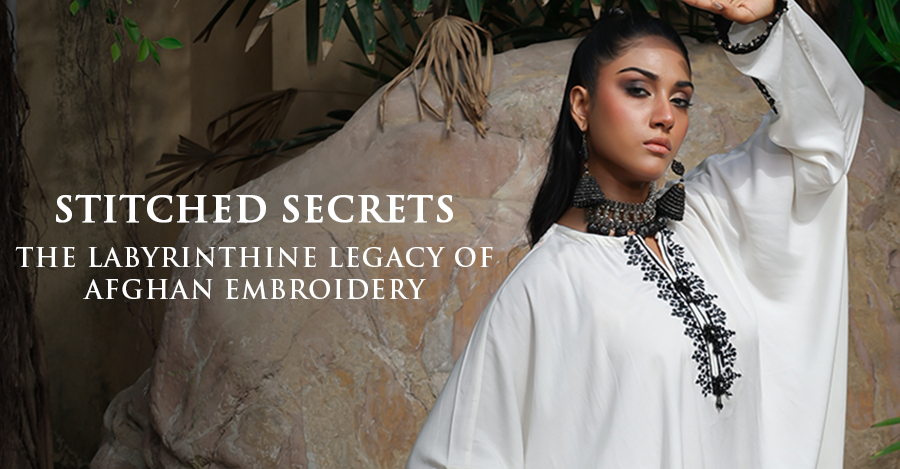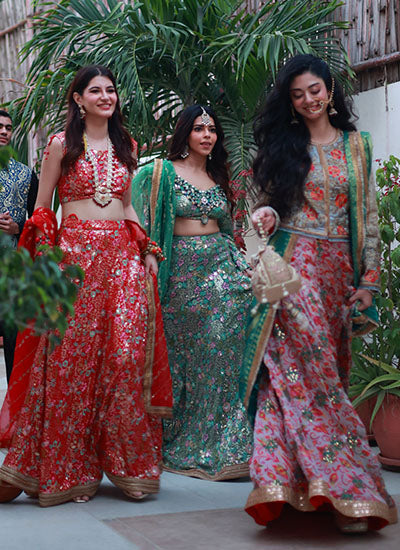Stitched Secrets: The Labyrinthine Legacy of Afghan Embroidery

In the labyrinth of Afghan culture, where mountains breathe ancient tales and deserts hum forgotten lullabies, embroidery is a language stitched in silk and sorrow—a rebellion woven in gold and grief. For centuries, this intricate art has passed from grandmother to granddaughter, not as an inheritance but as a second tongue: silent yet roaring.
Afghan embroidery, with its hypnotic geometries and repetitions, is a cartography of identity, mapping histories of conquest, resilience, and artistry. Among its many stitches,
Pukhta Dozi (the "firm stitch") and Zanjeer Dozi (the "chain of memory")
stand as titans—one tight and tenacious, the other fluid as a poet’s verse.
These are not mere techniques; they are the DNA of Afghan storytelling, each thread a
syllable in an epic poem.
These stitches evoke an era when every woman knew her needle was her voice, and embroidery was her armor. Let’s explore them—one loop at a time.

Pukhta Dozi: The Fortress Stitch
"A stitch so tight, it could hold back time."
Pukhta—Persian for "solid" or "firm"—lives up to its name.
Often described as the backbone of Afghan embroidery, this stitch embodies the spirit of the women who have preserved it through generations. Its tight, interlocking stitches form a robust foundation, mirroring the unyielding mountains of the Afghan landscape.
Imagine a grandmother sitting by the hearth, her nimble fingers dancing over the fabric, each stitch a note of wisdom shared with her granddaughter. The patterns often depict nature—flowers, trees, and the flowing rivers of Afghanistan—inviting the beholder to appreciate the beauty of the world around them. Pukhta Dozi is a narrative woven into the very fabric of Afghan legacy.

Gul Dozi: The Floral Symphony
Ah, Gul Dozi is a floral symphony in fuchsia and saffron.
The word gul (flower) is Afghanistan’s love letter to nature, blooming onto cottons and velvets like spring onto arid land.
Each uniquely crafted blossom symbolizes growth, beauty, and life’s fleeting nature—a poignant reminder of cyclical existence. Gazing upon Gul Dozi, one is transported to sun-drenched meadows where wildflowers sway in the breeze. The intricate details of each stitch evoke a sense of wonder, inviting viewers to uncover the stories behind the designs.
Whether it’s a simple blossom or a complex bouquet, Gul Dozi captures the essence of Afghan culture, celebrating the aesthetic brilliance that flourishes even in adversity.


Taka Dozi: The Gentle Whisper of Precision
Taka Dozi is the minimalism of Afghan embroidery, a whisper among shouts. Often done with a single thread, this delicate stitch dots fabric with symmetrical softness.
Used in fine detailing or subtle borders, it’s the embroidery equivalent of a
Mona Lisa smile—understated, but unforgettable.
In refugee camps across Pakistan and Iran, Taka Dozi has become an accessible livelihood for displaced Afghan women. With limited resources but limitless patience,
women craft perfection in borrowed time and space.
Every taka, every dot, is a soft defiance against being forgotten.

Zanjeer Dozi: The Chain of Connection
In stark contrast, zanjeer dozi, or "chain stitch," weaves a narrative of bonds.
Its looping patterns resemble interlinked chains, symbolizing familial and communal ties.
Each loop reminds us that, like stitches, we are part of a larger tapestry.
Often used in outlining floral patterns or bordering motifs, zanjeer dozi mirrors nature’s interconnectedness. When an Afghan woman embroiders this stitch, she’s not just stitching tradition—she’s braiding belonging.

A Historical Mosaic: The Evolution of Afghan Embroidery
The history of Afghan embroidery is as rich and complex as the stitches themselves. Dating back to the ancient Silk Road, this art form was influenced by various cultures and civilizations that traversed the region. From Persian motifs to Indian patterns, Afghan embroidery absorbed and adapted, creating a unique style that is instantly recognizable. The interplay of colors and designs reflects the diverse ethnicities of Afghanistan, each contributing their own flair to this vibrant tapestry.
As we delve deeper into the past, we find that these stitches were not merely ornamental but served practical purposes as well. Traditionally, Afghan women would use their embroidery skills to create dowries, crafting exquisite pieces that would be passed down through generations. This practice not only showcased their artistic talents but also served as a means of economic empowerment, allowing women to contribute to their families and communities.

A Stitch in Time Saves Nine
As we unravel the world of these handcrafted stitches, we discover that each thread carries a saga, each pattern a reflection of human experience.
From the sturdy embrace of pukhta dozi to the interconnected loops of zanjeer dozi, these stitches are a testament to the fortitude and resilience of the Afghan people.
They remind us that, in a world that often feels fragmented, there is splendor in connection, strength in heritage, and magic in the act of storytelling through needlework.
At its heart, Afghan embroidery breathes life into identity, weaving a timeless chronicle that echoes across time and space. Each stitch beckons you closer,
inviting a quiet reverence for the tales hidden within its patterns.
Within every thread, a legacy quietly waits to be unearthed—an ever-present reminder
of creativity’s unfading power and cultural endurance.

